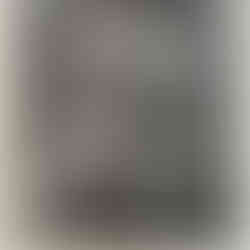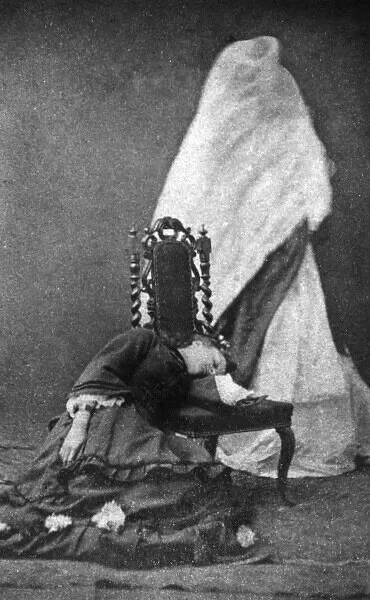The Materiality of Materialisation
- Hatts Bennett
- Jul 20, 2023
- 5 min read
Updated: Aug 8, 2025
There is a shared universal notion that the home should act as a womb-like sanctuary. The warm and cosy refuge protects the inhabitants from dangerous tempests of the alien ‘outside’. Again, similar to a vagina you are permitted to enter in by those you love, the space is reserved for only you, apart perhaps from a couple one-off visitors every so often. It is furnished with a soft cushioned tactility, warmth and sources of nourishment. As the physical and symbolic embodiment of comfort and safety it is not surprising the lengths people go to to protect it.
It has been proven that the home's permeable orifices such as chimneys, roofs, floorboards have been plugged with unlikely objects, such as, deceased cats, children's shoes, and witch bottles filled with nails, human hair and urine. This was happening during the early modern period, and likely long before this although this is less evidenced. Much effort has been undertaken by the disciplines of archaeology, anthropology and history to understand the evidence of these domestic popular magic rituals. Although there is contestation of the purpose due to little written primary sources on the subject, it’s generally agreed that in their original context they were intentionally placed and then concealed to deter evil corruption of malevolent forces. This worked to buttress the safety of those inhabiting the sacred bowels of comfort and to also possibly attract good fortune. The objects have been been defined as 'apotropaic', additionally the term “spiritual middens,” has been coined by scholar Timothy Easton. In some cases it’s been believed that the bad spirit will think the object, for example a garment or shoe, is the owner itself and be deterred, or it will be lured in by the distributed personhood of in there and trapped in there.
In the next century the domestic was still a site of supernatural goings on. This was during the rise of the spiritualist movement from the mid 19th century onwards. The greatest contrast with the earlier apotropaic rituals and these were that magical forces were instead generously invited into the home. Spirits would communicate through mediums to an audience during a fiscally driven, arguably fraudulent, theatrical performance. In the context of this era, the ‘ideal’ woman was to be pleasant, pious and passive, and was discouraged from working in the outside realm. The home acted as a comfortable prison, instead of perhaps the vaginal refuge aforementioned, due to exactly that, their sex. However, it was the stereotypical characteristics of femininity that hindered their chance to participate in the professional sphere that was actually thought to make women the ideal vessel for mediumship. If she was impressionable, sensitive, without intellect then surely she was ideal to be entered into by entities other realms. Allegedly, spirits were channelled and exerted through the female body through the physical form of sounds, actions, speech, and additionally apparitions of spirits through a materialisation called ectoplasm. The Fox sisters, Florence Cook and Victoria Woodhull are notary ‘physical mediumship’ key players at this time, using curtained areas of the domestic where there was a profound psychic concentration known as a ‘cabinet.’
The emanation of ectoplasm was captured through the medium of a camera, producing a physical record of a spiritual fleeting moment. However, another seventy years later the mediums were not surrounded by diaphanous ghost-like representations as in the 19th century, instead the now more technicallly developed camera was a witness to and would evidence a more tangible materiality of materialisation. In this context, families were experiencing great bereavement after the first world war, and subsequently mediums were sought after. Professionally monetising her gift from around 1916, Helen Duncan was an infamous physical medium whom could reunite the audience with their dead loved. She gave them an opportunity to see and touch the transcendental eerie ectoplasm and communicate with it. Duncan was born in 1897 and died at 59, she had a life as theatric and dark as the images of her seances. Nicknamed “Hellish Nell,” her life was shadowed by traumatic events, first falling pregnant out of wedlock in 1914, she went through invasive procedures and dissenting reports, including a trial attempting to debunk her clairvoyant abilities, numerous arrests leading to a six month stint in Holloway prison. Unbelievably, she was imprisoned in 1944 under the 1735 Witchcraft Act after allegedly describing the disaster of HMS Hood before it was public knowledge.
Duncan was said to have sat in the spirit cabinet flanked with curtains, previously having showing three female audience members her naked body, wearing a black satin garment of one piece drawn tightly at the neck, ankles and wrist. A red light was shone, producing a charged energy, and her trance would commence. The ectoplasm would then ensue from her body, at times resembling a face, which the audience could engage with several of theirsenses. In 1933 Harry Price, founder of the National Laboratory of Pyshcical Research, paid Duncan to come in order to debunk her abilities. Using speculums and gloved fingers to probe inside her cervix and anus for proof she was hiding ectoplasm, he stated, "every orifice of her body was medically explored." After nothing was found, he declared that the source of the hidden store was the stomach and she was reguritating the ectoplasm, comparing her to a cow with a second stomach. He called her a "fat female crook", "hysterical," "unruly," and "unkempt." However, nothing was factually proven.
I will now make an effort to rectify the misogynistic rhetoric and actions against her, from Price, the mocking tabloids during her trial, and significantly the use of the Witchraft Act used against her. Heinously, she was imprisoned by a patriarchal authority in spite of the modern age and Duncan has still not been pardoned today. This act connotes with the witch hunts that had decimated female control over their bodies, laying the foundations for the oppressive patriarchal structure, (Federici, 2003 p.14) and was resposible for the massacre of thousands of women, simultaneously destroying established female discourse and culture. Simon Featherstone writes that Duncan was a skilled perfomer of 'dark theatre,' and that the theatrical experience she created for the audiences posed "radical questions about the limits and meaning of representations of gender and class in the unregulated venues of the spiritualist circuit." He declares that she had an "extravagant display and management of her body and deployment of a range of references to popular materials, including puppetry, melodrama, children's games, and sentimental narratives." Moreover, Duncan was known to have repetaledly chanelled Arthur Stewart who was a swearing Scottish emigre to Australia. This perhaps was a strategy to escape and rebuke the patriarchal limits and systems she'd so often encountered. Forbidden to experience the autonomy of the male social role she was transgressing boundaries. Indeed, it's also been suggested by another research, Joe Nickell, that she employed her skills a seamstress to cleverly hide the ectoplasm. Therefore, she created complex acts of disobedience and defiance through the use of her body, with speech, gesture, movement and skills of craftsmanship, gaining her autonomy which had been repeatedly stripped from her.
Personally, her greatest legacy is the collection of photographs taken by Cambridge University Library from the archive of the Society of Pyschical Research. They show a sample of ectoplasm taken from a seance by Duncan in her home. They dance with ephemerality and are stateless, resembling vapour, light, liquid and material all at once. The textile is so far from being rooted in the everyday human experience and evoke a spiritual transdendant atmosphere that is equal to the grandiose concepts of magic, transgression and beauty.























Comments